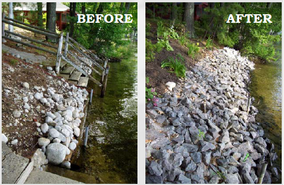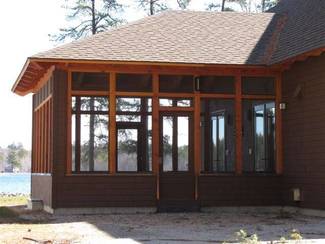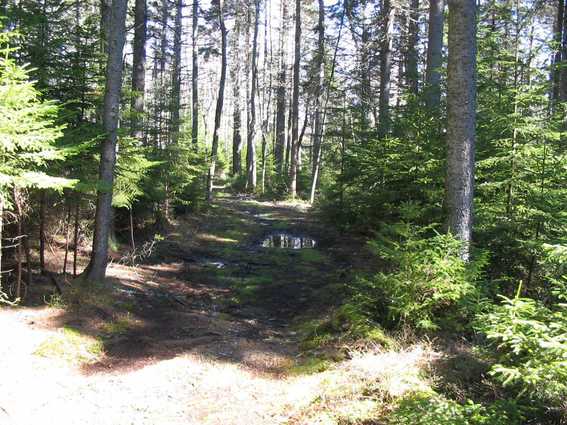Spring 2015 Vol. 28 No. 1
In this edition:
|
I want to take this opportunity to thank everyone who participated in the process of bringing the amendments to Chapter 1000 to completion.
We began the process with gathering input from you, our stakeholders. Your participation and the information you shared was invaluable to the final product which we discuss in more detail in this issue, thank you.
I also want to thank my Department staff who dedicated so many hours throughout the process. The DEP Shoreland Zoning Unit: Colin Clark, Stephenie MacLagan, Michael Morse and Policy Unit staff Mark Margerum.
|
|
 |
The amendments to Chapter 1000 Guidelines for Municipal Shoreland Zoning Ordinances became effective on January 26, 2015. Municipalities are encouraged to review the 2015 Guidelines to see the changes that need to be incorporated into their local ordinances.
The amendments to the Guidelines mark the completion of our rulemaking process, which aimed to address legislation passed since 2010 and address the concerns raised by stakeholders who met in 2011. Rulemaking hearings and comment periods occurred in 2014. The Department is grateful to all those who participated in this process.
The Guidelines cannot be adopted verbatim as a local ordinance. The provisions of the Guidelines must be modified for local adoption. Shoreland zoning staff members are available to assist municipalities with this process, and there will be training opportunities where we will discuss the
specific changes to the Guidelines (see Training article below).
In addition to many clarifications and corrections throughout, the amendments primarily affect the following sections of the Guidelines:

- Nonconforming structures
- Timber harvesting
- Vegetation
- Nonvegetated surfaces
- Disability variances
- Definitions
- Shoreline stabilization
- Structures and uses extending over, or located below, the shoreline
The many options in the
Guidelines allow municipal officials to tailor standards for each local
community. It is important for amended
ordinances to be consistent with the Guidelines, because ordinances must be
approved by the Department in order to become effective. Contact shoreland zoning staff early in the amendment drafting process.
|
To assist you with amendments,
it is helpful for shoreland zoning staff to know:
-
Whether you are looking to draft
certain amendments or bring the entire ordinance into consistency with the 2015
Guidelines
- How soon you would like to
hold a public hearing and adopt amendments
- Who will be involved
(planning board, committee, council) and who will be the appointed drafter
(computer user)
- Whether local officials
need more information about options, in order to make choices on ordinance amendments
Before you adopt ordinance amendments, you are welcome to send us your draft language for an informal review. Shoreland staff will meet your time frames as much as possible. These informal reviews may help ensure Department approval after local adoption.
In order for adopted
amendments to become effective, please remember to have a copy of the ordinance
and map, attested by the clerk after adoption, mailed to your regional
shoreland zoning staff member for Department review. Please remember to clearly
indicate the specific amendments, such as submitting the warrant article
language or a separate copy of the ordinance with tracked changes. The
municipality may instead vote on the entire ordinance, seeking full consistency
with the 2015 Guidelines, but please indicate this when submitting the
ordinance.
Within 45 days, a
Department order of approval or conditional approval will be mailed to the
municipality. With good planning by the municipality, it is rare for the
Department to issue an order of denial.
 Based on the volume of phone calls we’ve received from both municipal officials and landowners it is very clear that the new nonconforming structure expansion language has generated a lot of interest! The provisions regarding expansions in the Chapter 1000 Guidelines have been substantially modified as part of our recent rulemaking.
These new provisions reflect the recent changes to the state statute. When a municipality chooses to amend the expansion section of its ordinance, it must be consistent with the 2015 Guidelines (see Amendments article above), but municipal officials have choices for how to tailor these provisions for their communities.
We introduced the expansion provisions to you in the summer 2014 edition of the Shoreland Zoning News. The new provisions limit expansions of nonconforming structures based on footprint and height, instead of floor area and volume. The change intends to be simpler and more aligned with the purposes of shoreland zoning. Depending on circumstances of specific lots and structures, this change could be viewed as being more restrictive in some cases or less restrictive in other cases for landowners.
While there is no deadline currently, municipalities are encouraged to amend local ordinances to the footprint and height limitations, in order to remain consistent with the state statute and the Guidelines. Also, municipalities are allowed to have more restrictive ordinances; although, it is recommended that such ordinances are further supported by a comprehensive plan. Omitting any or all of the exceptions provided in the Guidelines would be more restrictive on landowners, but would provide municipal officials fewer standards to administer and enforce.
Municipal officials have choices with regard to the new provisions. The provisions limit footprint by square footage or percent, whichever allows more expansion. Including both limitations would provide landowners with the choice to decide which limitation to apply to their property. Municipal officials may instead choose to include only one of the limitations, either square footage or percent. This would be more restrictive on the landowner, but would be simpler for municipal officials to administer and enforce.
Shoreland zoning staff members are available to assist municipal officials in making these choices (see Amendments article above). There will also be training opportunities (see Training article below) that municipal officials may wish to attend to learn more about the new provisions.
|
Municipalities
are encouraged to review the 2015 Guidelines for ordinance amendments, and to make a choice about the regulation of timber harvesting in the
shoreland zone. Municipalities that amended their ordinances since 2006 to
adopt statewide standards for timber harvesting still must amend their
ordinances to be consistent with the 2015 Guidelines (see Amendments article above).
Timber
harvesting in the shoreland zone is regulated by the Maine Forest Service (MFS)
in municipalities that repealed the timber harvesting provisions in their
ordinances, which allowed the Maine Forest Service Chapter 21, Statewide Standards for
Timber Harvesting and Related Activates in Shoreland Areas, (SWS) to take
effect. MFS also enforces these standards jointly with municipalities that adopted
standards identical to SWS in their ordinances.
Municipalities that have not
amended their ordinances, or have a state-imposed ordinance, or have ordinances
not consistent with SWS, are responsible for enforcing their own ordinances
without MFS assistance.
 Where SWS are in effect, the MFS regulates “timber harvesting and related activities, including the construction and maintenance of roads used primarily for timber harvesting, and other activities conducted to facilitate timber harvesting.” Timber harvesting is defined in the SWS as “the cutting or removing of timber for the primary purpose of selling or processing forest products.” All other removal of vegetation in the shoreland zone is regulated by the municipality. When in doubt, contact your district forester.
Municipalities that had already adopted statewide standards must still amend their ordinances. There are amendments for bridge and culvert sizing, and an added section for referencing the definitions in Chapter 21, Statewide Standards. Any ordinance that is not consistent with the 2015 Guidelines is not consistent with the SWS. Contact shoreland zoning staff for further assistance with amendments.
Municipalities that have not amended ordinances since 2006 are encouraged to either repeal timber harvesting provisions or adopt SWS consistent with the 2015 Guidelines. Municipalities that have already repealed timber harvesting from their ordinances do not have to worry about timber harvesting, but there are other amendments that should be adopted in order to be consistent with the 2015 Guidelines (see Amendments article above).
Within the shoreland zone
of a coastal wetland, the shoreline setback for structures or other activities
is typically measured from the upland edge of a coastal wetland. The highest
annual tide elevation is the primary method for determining the upland edge of
a coastal wetland. The transition from highest annual tide to highest astronomical
tide has taken a little longer than expected, but the eventual result should be
worth the effort. With the Maine Geological Survey assistance, we
published the 2015 Highest Annual Tide (HAT) table.
Please apply the 2015 HAT
table elevations during your permitting review of site plans, when the surveyed
elevation method is used to identify the upland edge of a coastal wetland. Too
commonly, site plans depict the upland edge of a coastal wetland as the mean
tide line, mean high tide line, or simply as a lower elevation than HAT. The
HAT is the highest tide level in a
calendar year and is not at all close to a mean
tide. Please catch these problems so that we can improve consistency of
shoreland zoning permitting.
The eventual change to
highest astronomical tide will use a
tidal epoch data approach, where elevations are established over nearly 19
years of data collection, so that the table elevations will be applied for a
much longer period of time, multiple years instead of annual changes. This,
too, will improve consistency and benefit municipal permitting authorities,
surveyors and landowners.
Every year, shoreland zoning staff members present annual trainings. This year, the training schedule will be a little different, but we hope it provides more tailored options for the varying levels of experience and responsibility of local officials.
Shoreland zoning basic training online
Those preparing for their certification test or requiring the basics of shoreland zoning should participate or access this online training. We have planned for this training to be more interactive than previous online trainings. Participate during the live recording on April 23 at 1:00PM, or view online later. More details will be announced by the Department of Economic and Community Development.
Those who need contact hours can fill out and submit the evaluation form at the end. Please note that the information presented during this training will be based on the pre-2015 Guidelines since most municipal ordinances and the certification exam are based on the pre-2015 version of the Guidelines.
2015 Guidelines training online
This training will focus on the new provisions of the 2015 Guidelines. Comparison to the current standards will be limited. The amendment process will be covered in detail. The training will be interactively presented during a live recording on April 23 following the basic training but starting no later than 3:00PM. It can also be viewed online later. More details will be announced by the Department of Economic and Community Development.
This training is primarily intended for local officials who are just beginning the process of amending ordinances, in order to be consistent with the new provisions of the 2015 Guidelines. Those who need contact hours can fill out and submit the evaluation form at the end.
Workshops on 2015 Guidelines
In-person workshops will include a more thorough comparison of the current standards to the new provisions of the 2015 Guidelines, and briefly cover the process of amending ordinances. Local officials such as planning board members, in addition to code enforcement officers, are encouraged to attend. Information presented will be applicable whether or not the local ordinance was amended after the 2006 Guidelines. Please note that these workshops are not intended to replace basic training on shoreland zoning.
- Augusta, Florian Hall: May 28 from 9:00AM to 12:00PM, register at 8:30AM
- Caribou, NMDC: June 24 from 10:00AM to 12:00PM, please register
-
Lincoln, Region III: June 25 from 10:00AM to 12:00PM, please register
- Raymond, Public Safety Building: May 7 from 9:00AM to 12:00PM
Field workshops for code enforcement officers
A few field workshops will also be offered this year, some in conjunction with the above Workshops on 2015 Guidelines. The field exercises will demonstrate application of both current standards and new provisions of the 2015 Guidelines. These workshops are primarily intended for code enforcement officers.
-
Caribou, NMDC: June 24 from 1:00PM to 4:00PM, please register
- Greenville, Town Office: June 29 from 1:00PM to 4:00PM
-
Lincoln, Region III: June 25 from 1:00PM to 4:00PM, please register
- Milbridge, Town Office: June 26 from 9:00AM to 12:00PM
-
Raymond, Public Safety Building: May 7 from 1:00PM to 4:00PM
Since online training provides a more efficient way of presenting the basics of shoreland zoning, we can respond to ever-increasing requests for topic-specific training. We hope this will provide more and varied opportunities for experienced code officers to obtain their required contact hours.
|